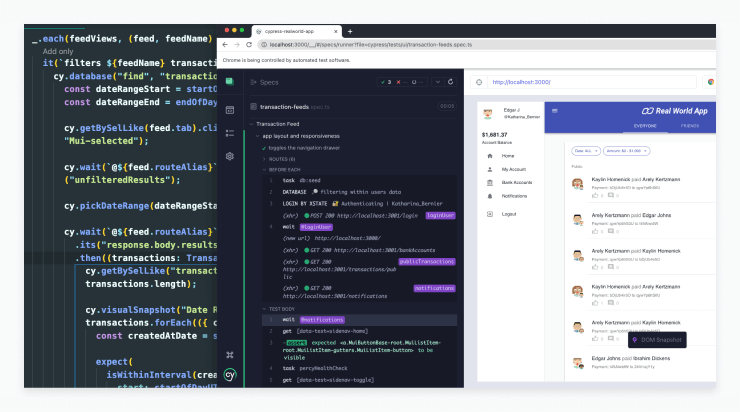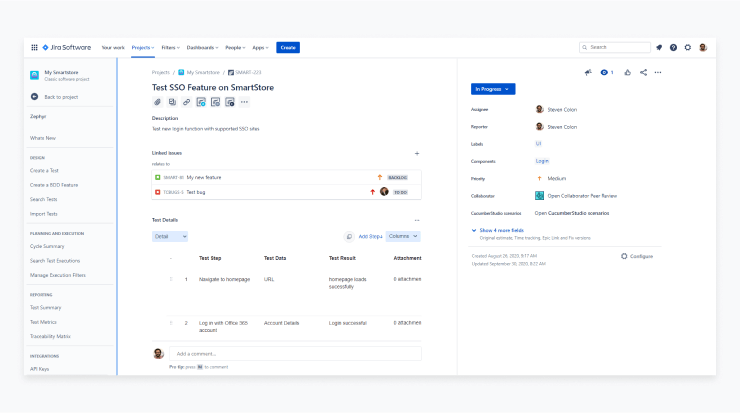Developing and executing a solid QA test plan is essential for guaranteeing software quality. From developing test cases, both manual and automated, to creating a plan that ensures comprehensive coverage of the system and components, a proper plan lays the groundwork for successful software testing.
This article provides 10 proven steps to help you quickly write a QA test plan. With these steps, you'll be able to optimize your available resources and adhere to tight timelines while creating an effective software test plan that helps you meet your business goals and deliver high-quality software.
- Why do I need a QA test plan?
- Core components of a QA test plan
- How to write a QA test plan quickly in 10 proven steps
- Understand the product and users
- Define the testing objectives
- Develop a clear test strategy
- Document risks & known issues
- Choose a testing environment and tools
- Outline a defect tracking process
- Identify test resources & responsibilities
- Define a testing schedule
- Decide on test deliverables
- Review test plan with stakeholders
- QA Test Plan Template (Google Doc)
- Conclusion
Why do I need a QA test plan?
A software test plan serves as a roadmap to guide the software testing process, ensuring that the final product aligns with the business requirements and meets the highest quality standards. As such, test plans are an integral part of the software testing life cycle and broader software development life cycle for several notable reasons:
- Sets clear testing objectives: It provides a clear understanding of what needs to be tested, how it will be tested, and the expected outcomes, reducing ambiguity and providing a clear focus for the test manager and broader testing team.
- Ensures comprehensive coverage: The plan includes the different types of testing that need to be performed, such as unit testing, integration testing, and system testing. This ensures all aspects of the software are thoroughly evaluated.
- Facilitates risk management: Test plans help identify potential issues early in the development cycle. By anticipating and mitigating these risks, the plan minimizes the likelihood of costly post-deployment fixes.
- Promotes consistency and efficiency: The plan provides a structured and repeatable testing process, resulting in more accurate results, better use of resources, and increased productivity of the testing team.
- Improves communication and collaboration: The test plan acts as a shared reference document for QA team members and other stakeholders, ensuring everyone is aligned on the goals, test tools, test approach, and general procedures that will be followed throughout the testing project.
For startup founders outsourcing SaaS development, a well-defined QA test plan is the best tool for maintaining control over the product quality, ensuring product's market readiness and customer satisfaction during often dynamically changing startup MVP development.
Core components of a QA test plan
We’ve looked at why a solid test plan is critical, but what exactly should a testing team include in the test plan document? Let’s look at the core components:
- Product overview: A brief overview of the product being tested, its use cases, and some information about its users to help set the stage for the rest of the plan.
- Test objectives: Clearly defined goals and objectives of the testing activities, aligned with the project requirements.
- Test strategy: An outline of the test strategies, including the types of testing (functional, non-functional, etc.), testing levels (unit, integration, system, etc.), and testing methodologies (manual, automated, etc.) to be used during the test phase.
- Risk assessment and contingency plan: Identification of potential risks and challenges associated with the testing activities, along with strategies to mitigate or address them.
- Test environment: A description of the hardware, software, and tools required to set up the test environment, including any dependencies or prerequisites.
- Test entry, suspension, and exit criteria: Clearly defined test criteria that must be met before testing can begin (entry criteria), conditions that would cause testing to be temporarily paused (suspension criteria), and conditions that must be met before testing can be considered complete (exit criteria).
- Test data: Information on the exact data to be used for all test cases, including any necessary data preparation or management activities.
- Defect tracking process: Test procedures for documenting defects found during testing.
- Test resources: A list of personnel involved in the testing process, their roles and responsibilities.
- Test schedule: A timeline of testing activities, including start and end dates, milestones, and any dependencies.
- Test deliverables: A list of artifacts and documents to be produced during the testing process, such as test cases, test scripts, and test reports.
How to write a QA test plan quickly in 10 proven steps
Finding the time and resources to devote to test planning can be a real challenge for software teams that are stretched thin and expected to meet tight delivery deadlines. In this section, we’ll walk you through 10 proven steps to help you overcome this challenge, so you can quickly create a test plan that will serve as a roadmap for efficient software testing and validation.
We’ll also provide tips and examples in each section to help you conceptualize what the final test plan could look like. If you’re looking for a QA test plan template, you can download one here.
Understand the product and users
To write a QA test plan quickly and effectively, it's crucial to begin by laying the foundation: develop a clear understanding of the product, its features, and the user base. To achieve this understanding, the test manager should review product documentation, project requirements, and stakeholder expectations. It is a best practice to interview product managers, developers, and other stakeholders directly in order to gather the most accurate information.
Next, delve deeper into the users' perspective to:
- Identify the primary user personas and their use cases
- Familiarize yourself with the technology stack and system architecture
- Understand the overall project timeline, milestones, and dependencies
- Analyze the product's competitive landscape and unique selling points
- Document user workflows and the expected outcomes for each
Once you have secured this information, you are ready to create a test plan with the broader test team.

Define the testing objectives
With a strong foundation in place, it's time to set clear goals for your test team. Clearly define the objectives for the testing effort, such as validating functionality, verifying performance, assessing security, or ensuring usability. Establishing these specific objectives helps you set priorities and allocate resources effectively as part of the broader test management process.
Start by identifying what needs to be tested:
- Identify the key features and functionalities to be tested
- Determine the non-functional aspects that need to be validated (e.g., performance, security, usability)
Then, align your objectives with broader project considerations:
- Consider compliance requirements or industry standards that the product must adhere to
- Align each test objective with project goals and customer expectations
- Prioritize objectives based on project scope, timeline, and available resources
- Define the expected outcomes and success criteria for each testing objective
- Establish a process for tracking progress against objectives and adjusting the test plan as needed
Example:
| Objective | Success Criteria | |
|---|---|---|
| 1 | Verify that all features of the online grocery shopping app work as per requirements and intended design. | All features, including item search, shopping cart management, checkout process, order tracking, and customer support functionalities, should work without errors. Each feature should perform as per the description in the requirements document. |
| 2 | Ensure the app is user-friendly and intuitive, providing a positive user experience. | Test users should be able to navigate the app easily, find items, and complete purchases without needing assistance or guidance. User feedback should reflect satisfaction with the app's ease of use. |
Develop a clear test strategy
Now that you have a firm understanding of the product and clear test objectives, it's time to create a roadmap for achieving those objectives. A well-defined test strategy document outlines the general test approach, methodologies, level of testing, and types of tests that will be performed by the test team. This strategy serves as a blueprint for your test plan, guiding the test team's efforts.
Begin the test strategy documentation by outlining the testing methodologies that will be used to perform testing:
- Manual testing involves testers manually executing test cases without automated tools. It's useful for exploratory testing and situations where test automation isn't feasible.
- Automated testing utilizes tools, scripts, and software to execute test cases, improving efficiency and accuracy. It's ideal for repetitive tasks, load testing, and regression testing.
- Exploratory testing is an unscripted approach, where testers dynamically design and execute tests based on their skills and insights gathered during testing. It's valuable when specifications are limited or time is scarce.
Next, identify the testing levels and their sequence:
- Unit testing is the first level of software testing where individual components or units of a software are tested. It helps to verify the functionality of specific sections of the code.
- Integration testing involves testing the interaction between different software units. It's used to identify issues in the data communication among these modules.
- System testing is a high-level testing process where the complete system is tested in its entirety to verify that it works in accordance with its specified requirements.
- Acceptance testing is the final level of testing and validates that the system meets the required specifications and satisfies the user's needs. It's typically conducted by the client or end users before the software goes live.
Next, in your test strategy document, specify the types of tests that will be performed and define the test coverage and criteria for each testing level:
- Functional testing checks if all software functions align with the requirements. Test coverage includes all functional requirements and the test criteria is that all functions should perform as expected.
- Non-functional testing reviews non-functional aspects like performance, scalability, security, and user experience. Test coverage involves all non-functional parameters, and the criteria include meeting predefined performance benchmarks, security standards, and usability expectations.
- Regression testing is performed to confirm that software changes, like bug fixes or new features, haven't caused new issues. Test coverage primarily involves modified software areas, and the criteria is that no new defects should arise due to these changes and the software should function as expected.
Finally, establish clear processes and guidelines for the testing process itself. This includes developing guidelines for creating, reviewing, and maintaining test cases to ensure consistency and accuracy. Additionally, you should establish standardized processes for executing tests, as well as for monitoring and reporting results. This will streamline your testing process and enhance communication among team members, ultimately ensuring a more effective and efficient testing cycle.
Example:
| Strategies Used | |
|---|---|
| Testing methodologies |
|
| Testing levels and sequence |
|
| Types of tests, coverage, and criteria |
|
Document risks & known issues
Ensuring a smooth testing process requires anticipating potential risks and challenges that may arise during the testing process. Analyzing these risks, developing contingency plans to address them, and monitoring their evolution is essential for maintaining a proactive and adaptable approach. To manage risks effectively, consider the following steps:
- Identify possible risks, such as resource constraints, schedule changes, or technical challenges
- Assess the likelihood and impact of each risk
- Develop mitigation strategies and contingency plans
- Assign risk owners to monitor and manage risks throughout the testing process
- Document known issues or limitations in the product that may impact testing
- Establish a process for updating the risk register and communicating risks to stakeholders
- Monitor risks throughout the testing process and adapt plans as needed
Example:
| Risk | Probability | Impact | Mitigation Plan | |
|---|---|---|---|---|
| 1 | Software security vulnerability | Medium | High (could lead to data breaches and loss of customer trust) | Implement strong security practices from the start, including data encryption, secure transactions, and regular security audits. Use automated testing tools to check for common vulnerabilities. |
| 2 | Delay in project schedule | High | Medium (could lead to increased costs, missed market opportunities, and stakeholder dissatisfaction) | Develop a realistic project timeline with built-in buffers for potential delays. Use agile methodologies to allow for flexibility in the development process. Regularly monitor project progress and adjust plans as needed. |
Choose a testing environment and tools
Transitioning from risk management to test execution, it's essential to create a suitable testing environment and select the right tools. This environment should closely mirror the production environment, ensuring accurate test results. Selecting the appropriate tools will help streamline the testing process and make it more efficient. To set up the testing environment, consider the following aspects:
- Specify the hardware, software, and network configurations required to replicate the production environment
- Ensure compatibility between the testing environment and the product's technology stack
- Validate that the test environment is properly isolated from the production environment to prevent interference
When selecting testing tools, consider the following factors:
- Collaborate with the development team to align on the choice of testing tools and environments. Consider their preferred stack and integrate tools that seamlessly fit into their workflows.
- Utilize virtualization and cloud-based testing platforms to simulate various testing environments without the need for physical devices. This provides flexibility, scalability, and cost-effectiveness.
- Integrate with CI/CD: this enables automatic execution of tests on code changes, ensuring quick feedback and streamlined workflows.
PRO TIP: Assess the complexity and scope of the project to determine the need for test automation. Depending on your team’s expertise, you could consider using automation tools such as:
- Cypress: A front-end tool for fast and reliable testing in a browser, providing real-time tests and easy debugging.
- Playwright: A Node.js library for automating multiple browsers, supporting a range of features and conditions, ideal for comprehensive browser coverage.
- Selenium: An open-source tool for automating web browsers across platforms, suitable for projects with complex workflows, including mobile web app testing.

Outline a defect tracking process
As you execute your test plan, it's crucial to have an efficient and effective process for tracking defects. This process should facilitate easy identification, documentation, prioritization, and resolution of defects found during testing while promoting collaboration between team members.
To create a robust defect tracking process, consider:
- Establishing guidelines for defect documentation, including severity, priority, and status, ensuring consistency in reporting and enabling better decision-making. Create a list of fields for each bug and workflows for reporting and resolution. Use a consistent naming convention, description, priority, and due date for bugs.
- Defining a workflow for handling defects, including assignment, review, resolution, and retesting, with clear handoff points between testers, developers, and project managers.
- Encouraging open communication and collaboration between testers and developers to expedite defect resolution and foster a shared understanding of issues. Everyone involved in the development process should be aware of the defect tracking tool and how to use it. This includes developers, testers, managers, and stakeholders.
PRO TIP: Select a suitable defect tracking tool that:
- Integrates with other tools used by the team
- Offers features like customizable fields, filters, and reports
- Supports duplicate detection to prevent duplication of efforts and streamlines defect resolution
- Has attachments and versioning to verify that the defect tracking tool allows attachments, such as screenshots, log files, or test artifacts, to be associated with defects
A few tool options to consider include:
- Backlog: An all-in-one tool offering bug tracking, version control, and task management for comprehensive project oversight.
- Jira: A renowned tool for robust bug tracking and management, with advanced reporting capabilities in software development processes.
- ClickUp: A cloud-based platform supporting bug tracking alongside task management, documentation, and goals, serving as an extensive solution for project management and team collaboration.
![]()
Identify test resources & responsibilities
Next, it's essential to identify the team members responsible for various testing tasks, their roles, and skill sets. Clear roles and responsibilities ensure that the entire testing process runs smoothly and efficiently while maximizing the strengths of each team member. To assign test resources and responsibilities, follow these steps:
- Identify the required roles for the testing process, such as test managers, test engineers, and test analysts, based on the scope and complexity of the project
- Assess the skill sets of the team members and assign them to appropriate roles based on their strengths, experience, and areas of expertise
- Clearly define the responsibilities for each role, including test planning, execution, and reporting, to establish accountability and set expectations
- Establish a process for collaboration and communication between team members to facilitate knowledge sharing, coordination, and efficient handoff of tasks
Example:
| Role | Name | Responsibilities | |
|---|---|---|---|
| 1 | Test Manager | John M. |
|
| 2 | Test Engineer | Alyssa S. |
|
| 3 | Test Analyst | Tom L. |
|
Define a testing schedule
To effectively manage the testing process, develop a timeline that includes milestones, deadlines, and dependencies. This schedule should take into account factors such as resource availability, test environment setup, and potential risks, allowing for flexibility and adaptability. To create a testing schedule, consider the following elements:
- Break down the testing process into phases and tasks, such as test planning, test case development, test execution, and test reporting, to make the schedule more manageable and trackable
- Estimate the time required for each task, considering factors like resource availability, test environment setup, and potential risks, using historical data or expert judgment
- Identify dependencies between tasks and account for them in the schedule to ensure a smooth flow of work and avoid bottlenecks
- Allocate buffer time for unexpected delays, risk mitigation, and defect resolution to maintain schedule flexibility and adaptability
- Monitor the testing schedule throughout the process, adjusting it as needed to accommodate changes in scope, resources, or risks, and communicate these adjustments to stakeholders
Example:
| Task | Task Description | Start Date | End Date | |
|---|---|---|---|---|
| 1 | Test planning | Prepare the test plan document, outline the testing objectives, strategy, and scope. | June 1 | June 4 |
| 2 | Test case development | Write detailed test cases based on the software requirements. | June 5 | June 15 |
| 3 | Test environment setup | Set up the test environment with appropriate hardware, software, network configurations, and test data setup. | June 16 | June 20 |
| 4 | Test execution and reporting | Execute the test cases, log defects, and report test progress. This phase is iterative, involving re-testing as issues are fixed. | June 21 | July 20 |
| 5 | Final test cycle and closure | Final cycle of testing, preparation of test reports, test metrics, and test closure activities. | July 21 | July 24 |
| 6 | Release | After ensuring all critical defects are fixed and retested, the application will be ready for release. | July 26 | July 26 |
Decide on test deliverables
To effectively manage and communicate the progress of your testing process, it's essential to decide on the key deliverables at each stage. These deliverables help monitor progress, ensure accountability, and provide valuable documentation for future reference. Consider the following test deliverables for each stage of testing projects:
Before testing:
- Test plan document: A comprehensive document outlining the testing objectives, scope, strategy, and schedule
- Test cases: Detailed descriptions of the inputs, expected outputs, and testing procedures for each test scenario
- Test design specifications: Documents outlining the test conditions, data requirements, and expected results
During testing:
- Test scripts: Automated or manual scripts used to execute tests and verify results
- Test data: Input data sets used to test the application under various conditions
- Test traceability matrix: A document mapping test cases to requirements, ensuring comprehensive test coverage
- Error logs and execution logs: Records of test execution, including identified defects and their status
After testing:
- Test results/reports: Summaries of test execution, including pass/fail status, defects, and testing metrics
- Defect report: A comprehensive record of identified defects, their severity, status, and resolution
- Release notes: Documentation detailing the changes, fixes, and improvements in the released product version
Establishing a standardized format for test deliverables, such as plans, cases, scripts, and reports, ensures consistency and ease of understanding across the team. Coupled with a central repository for storing these deliverables, this approach facilitates easy access and promotes collaborative efforts. Additionally, this central storage offers traceability, empowering teams to track changes and outcomes throughout the testing process, which aids in accountability and future testing endeavors.
Example:
| Deliverable | Delivery Stage | Task Description | |
|---|---|---|---|
| 1 | Test Plan Document | Before Testing | This document will detail the overall strategy and approach for testing the online grocery shopping app, including our objectives, scope, methods, schedule, resources, and responsibilities. |
| 2 | Test Design Specifications | Before Testing | This documentation will provide a granular view of the test conditions, data requirements, and expected results for each function of the application. |
| 3 | Test Scripts | During Testing | These will be a mix of automated and manual scripts used to conduct tests under various scenarios and to verify the results. |
| 4 | Test Traceability Matrix | During Testing | This document will map each test case to its related requirement, ensuring that we have thorough coverage and that all functions of the application are tested adequately. |
| 5 | Defect Report | After Testing | This will be a comprehensive record of all identified defects during the testing phase. Each entry will detail the defect's severity, status, the steps to reproduce it, and the measures taken to resolve it. |
| 6 | Release Notes | After Testing | Once we're ready to launch a version of the online grocery shopping app, we'll compile release notes that detail all changes, fixes, and improvements in that version. This will help inform both the team and stakeholders of the state of the application at the point of release. |
PRO TIP: There are a number of tools available that can help you manage and track deliverables. Some of the most popular include:
- Jira (with plugin Zephyr): Jira, a project management tool, enhanced with Zephyr, supports test case creation, planning, execution, and allows for detailed tracking of testing cycles.
- Confluence: An integrated tool by Atlassian for project documentation, it promotes collaboration and knowledge sharing, ideal for managing and tracking test artifacts.
- TestRail: A comprehensive web-based test case management tool that allows for tracking, managing, and organizing testing efforts and results.
- Testiny: An intelligent, AI-powered testing tool that automates the creation of test cases, improving efficiency and the quality of the testing process.

Considering the project structure it might also be worth looking at common tools like Google Docs, Sheets, Slides, OneDrive or Dropbox and Git/GitHub/GitLab (for managing test scripts and other test artifacts). Ultimately, the best tool for you will depend on your specific needs and preferences.
Review test plan with stakeholders
Before beginning the testing process, it's crucial to review the test plan and test estimation with stakeholders and the development team to ensure its completeness, accuracy, and alignment with project objectives. This collaborative review process helps identify gaps, address concerns, and build consensus. To effectively review the test plan, you should:
- Present the test plan, highlighting key objectives, test scope, strategy, and schedule with stakeholders, including project managers, developers, and product owners.
- Encourage open discussion, inviting feedback and suggestions for improvement of the test plan.
- Obtain approval from stakeholders before beginning the testing process, ensuring alignment and buy-in especially on the core testing objectives, schedule, and budget.
QA Test Plan Template (Google Doc)
Ready to download your own QA test plan template? Get your copy here.
Need more hands-on help with your QA test plan?
At SoftKraft we provide software product development services. We take project ownership and responsibility for decisions that were taken during the development. Success of the project is the only metric that really matters to us.
Conclusion
Developing a robust QA test plan is crucial in guiding the software testing process, managing risks, and ultimately ensuring the delivery of a high-quality product. The aim is to create an efficient roadmap for testing, making the best use of your resources and adhering to deadlines, all while keeping the end goal in sight – delivering high-quality software that aligns with business requirements and user expectations.
In this guide we’ve looked at 10 proven steps to help you write an effective QA test plan quickly. If you’re looking for more support with QA testing, our software development company can help. Contact us today to learn how we can help.




![AWS Security Incident Response Plan [Practical Guide]](/uploads/aws-security-incident-response-plan.png)

![Incident Response Plan Template For Startup [SM, MD, XL]](/uploads/incident-response-plan-template.png)
